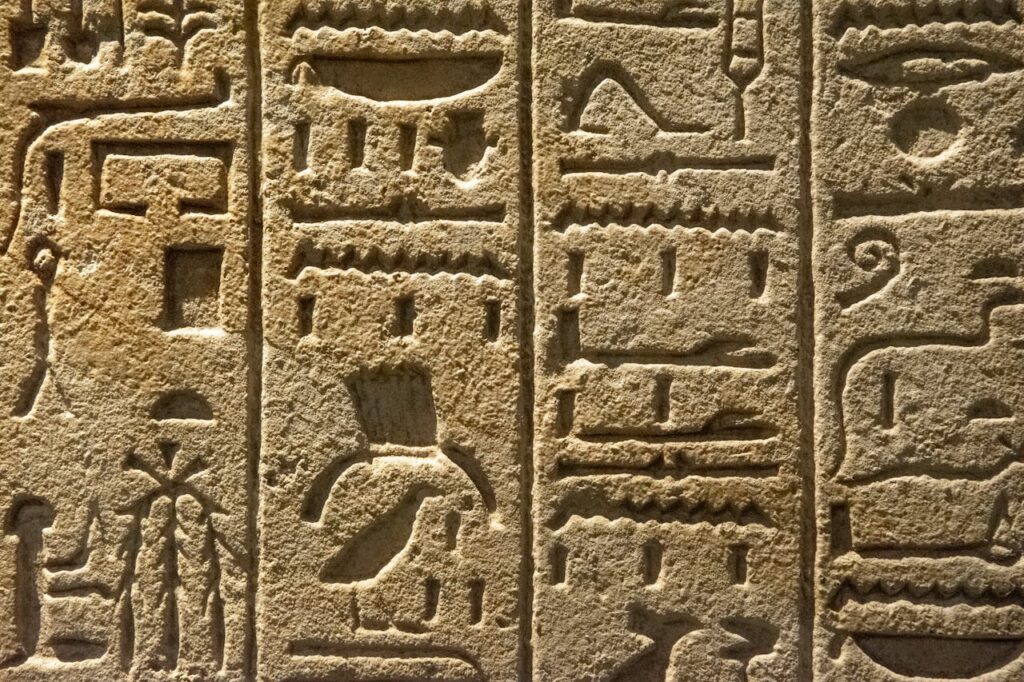I first became aware of British Egyptologist Dr. David Rohl’s revised Egyptian Chronology not long after his book A Test of Time was published in 1995. I was an undergraduate at Central Christian College of the Bible and was taking a course on archaeology where Rohl’s views were advocated as a legitimate possibility which could lead to more archaeological support for the Bible. However, Rohl’s views drastically contrasted from the generally-accepted dating used by most Egyptologists and historians. So, I filed the information away as interesting, but I wasn’t going to pursue the line of thinking unless Rohl’s views began to gain some traction in the academic world.
Jumping forward twenty years, I was looking for some videos to supplement a class I was teaching on the Pentateuch, and I ran across the documentary Patterns of Evidence: The Exodus and encountered Rohl’s views being advocated again. So, on the popular level, Rohl’s views are still being disseminated to the masses. However, most scholarship, including among some professed Christians, has not been accepting of Rohl’s views. So, this brief article will attempt to educate on Rohl’s Egyptian Chronology and make some suggestions as to why it is considered a flawed approach.
The Traditional Chronology
To understand Rohl’s work, it is necessary to examine the generally-accepted dating of Egypt’s pharaohs and how this was agreed upon. Much of the assumptions of Egypt’s chronology come from Manetho’s listing of the Pharaohs and their 31 dynasties. Manetho was an Egyptian priest of the 3rd century B.C. who compiled a list of the Pharaoh’s of Egypt into 31 dynasties. His work is now lost, only surviving in some quotations by the church fathers. With some revision, Manetho’s work has been accepted by Egyptologists as relatively close and is supported by four major benchmarks, of which Rohl attempts to discredit three.
Egyptian history is traditionally divided into three “Kingdoms,” periods of power in which Egypt is a strong player on the international stage. In between these kingdoms are periods of national weakness known as Intermediate Periods. It is with the Third Intermediate Period that Rohl finds issues with the chronology, suggesting that dynasties 21 and 22 are not sequential. This (along with some adjustments to the 20th dynasty) leads to a gap of nearly 350 years which causes a radical realignment of Egyptian history with the rest of the ancient world, including the Bible. For example, the great pharaoh Ramses II, who was in the 13th century in the original chronology, becomes part of the 10th (a contemporary of Solomon and Rehoboam) in Rohl’s chronology.
“To understand Rohl’s work, it is necessary to examine the generally-accepted dating of Egypt’s pharaohs and how this was agreed upon.”
Rohl’s chronology has been popular due to its biblical correlations, particularly with Israel’s presence in Egypt. He suggests that we see evidence of Joseph’s tomb, the Israelite city at Avaris, and even an Egyptian record of the plagues of Egypt known as the Admonitions of Ipuwer which, though we have a later New Kingdom copy, dates by writing style into the Middle Kingdom where Rohl’s suggests the Exodus should be found. However, Rohl’s goes back and forth between a 13th-century Exodus and a 15th-century one. Most of the time when Rohl wishes to show that there is no evidence of the Exodus in the conventional chronology he uses the 13th century date, but the Bible in 1 Kings 6:1 and Judges 11:26 favor a 15th century date anyway. It’s a bit of a straw man. Most of the evidence of Israel in Egypt would still work for a 15th-century B.C. Exodus.
For some time, Egyptologists have recognized that the chronology of Egypt is difficult and minor revisions are probably warranted, but most Egyptologists are unwilling to make revisions at the level which Rohl does. So how did Rohl come to these conclusions?
Rohl began with noticing some oddities concerning the burial of Apis bulls at Saqqara. He noticed that they were missing from the 21st and 22nd dynasty. He also found an oddity where a 22nd-dynasty pharaoh had a tomb that was built before that of a 21st-dynasty pharaoh. This led him to begin to question the established dating and began to see challenges to 3 of the 4 primary pillars of Egyptian chronology.
Challenging the Pillars
The first of these four pillars is the sacking of Thebes by the Assyrians under Ashurbanipal in 664 B.C. while Psamtek I was on the throne. This is not debated by Rohls. However, the other three, he critiques:
- The identification of Shoshenk I with the biblical character of Shishak who attacked and humbled Rehoboam (see 1 Kings 14:25-26 and 2 Chronicles 12:2-9)
- The ascension of Ahmose in 1550 B.C. based on the helical rising of Sothis (the star Sirius) in 1517 B.C., the 9th year of Amenhotep I
- The accession of Rameses II in 1279 B.C. based on his year 52 being 1228 according to a lunar calendar date.
Shoshenk and Shishak. Rohl will argue that Shishak is not Shoshenk by arguing that Shoshenk’s inscription concerning his conquest in Palestine would not make sense if he attacked Jerusalem, as it would have been geographically out of the way. He also challenges on linguistic grounds the identification of Shishak with Shoshenk. He argues that Shishak would have been a Hebraization of a “hypocoristicon” (i.e., personal name, maybe equivalent to a nickname) of Ramses II, Sese.
“Rohl will argue that Shishak is not Shoshenk by arguing that Shoshenk’s inscription concerning his conquest in Palestine would not make sense if he attacked Jerusalem.”
The helical rising of Sothis. Rohl will also argue that the Sothic dating has problems. The basic idea of this pillar is the first rising of the star Sothis (Sirius) coincided the Egypt New Year Day. However, due to the fact that a year is actually 365.25 days, every four years Sothis would rise a day later. It would thus take 1460 years for Sothis to again rise on the same day. A document from Censorius (3rd century A.D.) mentions a coincidence of the rising of Sothis and the Egyptian New Year in A.D. 140. This then creates other anchor points by going back 1460 years from that date. However, Rohl will note that this dating depends on where the observations of Sothis were done and that the reading of some of the key papyri are debated, with some writers contradicting Censorius.
Accession of Rameses II. The question of the accession of Ramses II based on a lunar calendar meets a lot of uncertainty as several Egyptian calendars have been discovered and it is uncertain which lunar calendar was in use. Therefore, this pillar of conventional chronology is indeed uncertain.
Questioning Rohl’s Chronology
Again, most Egyptologists have rejected Rohl’s interpretation (see Bennett, Brissaud, and notably Kenneth Kitchen whose expertise in the Third Intermediate Period Rohl is especially concerned to call into question). They will largely base their arguments on evidence from the Egyptian side of the debate. However, Egypt, though a notable player, interacted with other nations who have established chronologies of their own.
Ironically enough, Assyrian chronology is a lot less complex than Egyptian as there are definitive fixed points in Assyrian history that we can work from. The most famous fixed point is the Bur-Sagale eclipse on June 15th 763 B.C. This solar eclipse (and others at other points in Assyrian history) is mentioned in the limmu or eponym year lists. In their records, the Assyrians named every year after an official (a “limmu”) and listed major events in the year, included that eclipse. Using this fixed point and the limmu lists (in which there are a couple covering most of the Middle Assyrian and Neo-Assyrian periods), we can assign dates to various rulers, which is how rulers in the Bible are dated.
So, if we can find an Assyrian ruler whose date is certain who corresponds with an Egyptian ruler, we can have a rough estimation when that ruler lived. The famous Amarna tablets are distinctly placed in the 18th dynasty of Egypt with most of them having been written to Amenhotep III and Amenhotep IV (better known as Akhenaten). An Assyrian ruler, Ashur-uballit I, who is dated to the 14th century, is mentioned in the Amarna texts which would give a 14th century date to Egypt’s 18th dynasty and a 13th century date to Egypt’s 19th dynasty of which Ramses II was from.
“Ironically enough, Assyrian chronology is a lot less complex than Egyptian as there are definitive fixed points in Assyrian history that we can work from.”
This is a big difficulty in Rohl’s theory, and he acknowledges the problem in an appendix to his work Test of Time. He notes that the patronym (Ashur-uballit’s father’s name) is different between the Amarna texts and the Assyrian records. He acknowledges, though, that the Assyrians would indeed claim any ancestor/predecessor as a father. Unfortunately, Rohl must assume the Amarna text is speaking about some other Ashur-uballit that is otherwise unknown. While there is a later Ashur-uballit II, his dates, while closer, would not quite match up with Rohl’s chronology either.
Unfortunately, direct contacts between Egypt and Assyria before the Neo-Assyrian period (about 900 B.C.) are relatively rare. Yet Assyria did have contacts with other people who also had contacts with Egypt. Most notable among these are the Hittites. If an Assyrian ruler can be identified as a contemporary of a Hittite ruler who is contemporary with an Egyptian, we can get a more definitive date on the Egyptian ruler. We know from Egyptian and Hittite records that Ramses II signed a treaty with Hattusili III (approx. 1275-1245). Hattusili III had a son named Tudhaliya IV (approx. 1245-1215) who fought the battle of Nihriya against the Assyrians as both Hittite and Assyrian records mention this. The Assyrian king in question was Shalmaneser I (1273-1244). This would make Shalmaneser I, whose date is more certain, a near contemporary of Ramses II. This in no way fits Rohl’s chronology.
Other issues arise with Rohl’s understanding of his chronology with respect to the biblical accounts of the early Israelite United Monarchy. Rohl finds within the Amarna letters references to Saul, David, and Ishbosheth. However, the Amarna letters themselves seem to indicate much greater Canaanite control of the land (though it is threatened by the nomadic “Hapiru”) than what the biblical accounts seem to have.
“Other issues arise with Rohl’s understanding of his chronology with respect to the biblical accounts of the early Israelite United Monarchy.”
Other archaeological remains also can be problematic to Rohl’s chronology. The famed Merneptah Stele mentions Israel as a group of people whose “seed was not.” The stele mentions several city-states and political entities, but when it gets to Israel, it’s different. It is given the designation of an unorganized people group. According to Rohl’s chronology, the stele would be dated in the late 10th century after the Israelite kingdom had already been established for 120 years. If, however, the conventional dating of the Merneptah Stele (approx.1210 B.C.) is correct, this would have placed it in the middle of the Judges period where indeed there was not a centralized political entity in Israel.
Dr. Bryant Wood also notes that Rohl’s chronology would make a mess of Israelite archaeology. A great many radiocarbon datings would have to have an error level of 350 years. Granted, there is some inaccuracy with radiocarbon dating (though it is improving), but for something 3000 years old, the discrepancy would be more or less 100 years, not 350. Also, the occupation levels of several sites (like Jericho and Hazor) would not match up well with Rohl’s dating.
Another significant challenge to Rohl’s dating scheme is found with the ancient enemies of Israel, the Philistines. Most archaeologists believe that the majority of the Philistine incursion into the Promised Land occurred in the 12th century after the defeat of the Sea Peoples by Ramses III of the 20th dynasty. The Philistines are identified with the Peleset of Egyptian inscriptions and by similar dress. Thus, they were in the Promised Land for the time period of the later Judges and the United Monarchy as a major foe of Israel. In Rohl’s chronology, however, the Philistines would not arrive in Israel till about 800 B.C., far too late to be a foe of Saul and David.
Conclusion
A great test of the viability of a theory is if it answers more problems than it creates. There is certainly some uncertainty in Egyptian chronology. Some artifacts, particularly of Israel while in Egypt (See the documentary Patterns of Evidence: The Exodus), are tantalizing in their correlation with Scripture if Rohl’s system is correct. However, Rohl’s chronology does create problems which has forced its advocates into trying not only to redate much of Egyptian history but Hittite and Philistine history as well (see Bimson’s work on redating the Philistines).
In conclusion, it is tempting for advocates of God’s Word to attach themselves to any theory that purports to support Scripture. David Rohl has gained a lot of notoriety due to the biblical connections we can make with his proposed chronology. However, each theory must be carefully examined with counterarguments weighed and evaluated, otherwise we might be accused of being uneven with the evidence—which undermines the credibility of those of faith.
Who knows? As more evidence comes up from the ground, Rohl may be proved correct, partially correct, or even way off base. Until that time, it must remain an interesting possibility.










